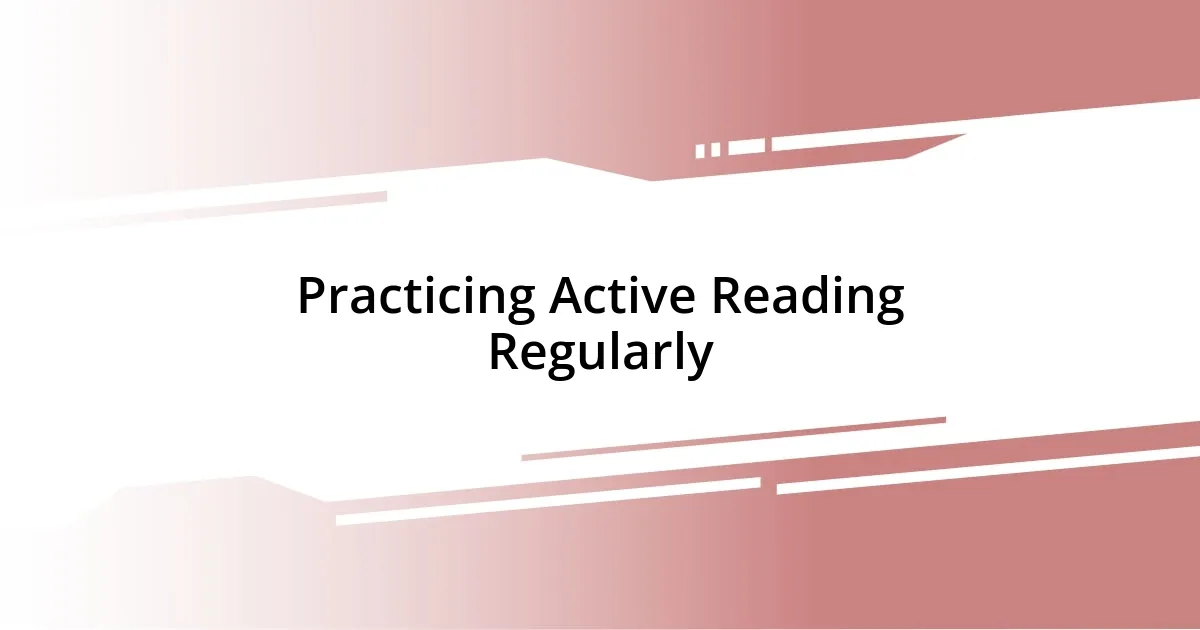Key takeaways:
- Active reading techniques such as note-taking, summarization, and questioning enhance engagement with the text and improve comprehension and retention.
- Setting clear reading goals provides direction, making reading sessions more purposeful and rewarding.
- Regular practice of active reading habits, including discussions and maintaining a reading log, fosters deeper understanding and connection to the material.

Understanding Active Reading Techniques
Active reading techniques are all about engaging with the text on a deeper level. When I first started practicing active reading, I noticed that simply highlighting text was not enough. Instead, I began taking notes in the margins about what I found interesting or confusing, which transformed my reading experience—suddenly, I was more invested in the material. Have you ever wondered how much more information you could retain by simply jotting down your thoughts?
Another technique I’ve adopted is summarization. After finishing a chapter, I pause to write a brief summary of what I’ve read. It might seem tedious at first, but it forces me to distill the main ideas and connect them in my mind. This method has been particularly rewarding; after summarizing, I often find myself keenly aware of any gaps in my understanding. Can you recall a moment when summarizing helped clarify something for you?
Finally, asking questions while I read has become a game-changer. I often pause to challenge myself: What is the author’s main argument? How does this relate to what I already know? These questions stimulate my curiosity and encourage me to explore the material more thoroughly. I can still remember a time when my inquiry into a text led me down a rabbit hole of discovery, connecting ideas I hadn’t considered before. Isn’t it fascinating how questioning opens new avenues of thought?

Benefits of Active Reading
Active reading offers numerous benefits, enriching not just comprehension but also retention. From my experience, the most remarkable aspect is the boost in focus and concentration. I recall reading a dense academic text that had me drifting off into daydreams; however, once I started actively engaging with the material—highlighting key points and taking notes—I found myself fully immersed. It was a revelation! Have you experienced that shift from distraction to deep engagement while reading?
Another significant advantage is enhanced memory retention. I’ve noticed that the more I engage with the text—whether through annotating or summarizing—the easier it becomes to recall the information later. There was a time when I had to prepare for an exam, and I created mind maps based on my notes; this visualization made all the difference, making the material stick in my mind. How do you usually remember important details?
Moreover, active reading cultivates critical thinking skills. When I’m actively questioning the material instead of passively consuming it, I become more adept at evaluating arguments and identifying biases. For example, while reading a controversial article, I found myself analyzing the author’s standpoint and considering alternative viewpoints. This has challenged me to think beyond the text, honing my analytical abilities. Isn’t it empowering to feel that your reading contributes to your overall thought process?
| Benefit | Explanation |
|---|---|
| Increased Focus | Active engagement leads to a deeper concentration on the text. |
| Enhanced Memory Retention | Engaging with material helps solidify information in long-term memory. |
| Improved Critical Thinking | Encourages analyzing arguments and understanding different perspectives. |

Setting Clear Reading Goals
Setting clear reading goals is essential for maximizing the benefits of active reading. When I first dipped my toes into structured reading, I used to stumble from one book to the next without a real purpose. But when I started setting specific goals—like reading a certain number of pages per day or tackling particular topics—I discovered a newfound clarity. Suddenly, my reading felt directed and rewarding, turning each session into a meaningful step towards my understanding.
Here are some tips I’ve found useful for setting effective reading goals:
- Define Your Purpose: What do you want to achieve? It could be to learn a new skill, enjoy a story, or prepare for an exam.
- Set Measurable Targets: Determine how many chapters or pages you want to cover in a session. This makes progress tangible.
- Schedule Your Reading Time: Consistency matters. Pick a regular time that fits your schedule, making reading a habit.
- Adjust as Needed: Don’t hesitate to modify your goals if you find them too ambitious or too easy. Flexibility can lead to better enjoyment and comprehension.
By slowly building these habits, I found myself not just reading more but truly eager for each new page. It’s almost like giving a map to your journey; that sense of direction transforms your experience!

Questioning the Text Effectively
Questioning the text effectively is a game-changer. Whenever I read something thought-provoking, I find myself jotting down questions that arise. For example, while reading a novel, I often ask, “What motivated the character’s actions?” This not only deepens my understanding of the characters but also immerses me more fully in the story. Have you tried this? It’s incredible how it shifts your focus from surface-level reading to a more analytical approach.
I’ve observed that questioning the material helps me clarify my thoughts. On one occasion, I was tackling a complex article about climate change. By pausing to ask, “What evidence supports this claim?” I forced myself to look for connections and contradictions in the text. This practice keeps me engaged and allows for a more critical assessment. Don’t you feel a sense of accomplishment when you dissect an argument instead of just accepting it?
Additionally, I’ve realized that asking questions can lead to unexpected insights. During a discussion on political texts, I asked, “What biases might be influencing the author?” This inquiry not only enhanced my understanding but also sparked a lively debate among friends, enriching our perspectives. How often do we miss out on deeper dialogues simply because we don’t question enough? I truly believe that cultivating an inquisitive mindset during reading expands our horizons and makes the entire process more rewarding.

Annotating for Better Retention
Annotating a text might seem like an extra step, but I can assure you it’s well worth the effort for retention. When I first started annotating, I was amazed at how simply underlining key phrases or jotting down thoughts in the margins increased my engagement. It was like having a conversation with the text! I remember reading a dense philosophy book where every note helped me unravel complex ideas. It turned what could have been a daunting experience into a journey of discovery. Have you ever tried writing your thoughts next to challenging concepts? It really transforms how you connect with the material.
One technique I find particularly effective is summarizing sections in my own words. After reading a difficult paragraph, I often pause to write a quick summary. This practice not only solidifies my understanding but also highlights any gaps I might need to revisit. I recall working through a challenging scientific article, and summarizing each section made it easier to track the main argument. I can almost feel the mental gears clicking into place when I do this! It’s satisfying to see knowledge take shape in my own writing.
Lastly, colored pens have become my best friends in the annotation process. I use different colors to categorize information, making it visually engaging. For instance, I might use one color for definitions and another for personal insights. This method unlocks a new layer of organization for my thoughts and serves as a helpful tool during review sessions. When I look back at my annotated texts, the colors jump out and spark memories of what I learned. Isn’t it fascinating how visual cues can enhance retention? If you haven’t given it a shot, I highly recommend exploring the colorful world of annotation!

Summarizing Key Points
Summarizing key points can feel like a chore, but I’ve found it to be an enlightening experience. When I finish reading a chapter, I often take a moment to pen down a few sentences that capture the essence. I remember combing through a lengthy history book; isolating the main ideas helped me connect the dots across various events. It was like putting together pieces of a puzzle—the clearer the summary, the easier it became to visualize the bigger picture.
I also think about how summarizing allows me to reflect on my learning. After reading a particularly dense article about mental health, I sat back to write a concise overview. That moment of reflection made me realize how the nuances of the text resonated with my own experiences. Sometimes I ask myself, “What do I take away from this?” and the answers often deepen my emotional understanding. Have you ever had a moment where your summary revealed more than you expected?
Moreover, I’ve noticed that revisiting these summaries is incredibly beneficial for long-term retention. When prepping for a recent book club meeting, I pulled out my summaries from previous discussions, and it was enlightening to see how my perspective had evolved. It’s almost like having a conversation with my past self! Connecting these dots makes the material feel alive and relevant. Honestly, when was the last time a summary sparked a new insight for you?

Practicing Active Reading Regularly
Practicing active reading regularly is key to developing a deeper comprehension of texts. I recall a time when I committed to making a habit of reading for just 20 minutes daily. Initially, it felt difficult to maintain focus, but gradually, the practice transformed reading from a chore into a fulfilling ritual. Have you ever experienced a moment where a simple habit completely shifted your perspective on an activity? For me, it was rewarding to see not only my understanding improve but also my enjoyment grow over time.
Another aspect I cherish about regular active reading is the consistency it brings to my knowledge retention. Once, I decided to pair my reading sessions with brief discussions with friends. These conversations added a lively element to the material and often led me to insights I wouldn’t have reached on my own. I often ask my friends to challenge my viewpoints after discussing a text. Engaging with their perspectives allows me to view the content through different lenses, enriching my experience. Have you tried discussing your readings with others? It can be eye-opening!
Lastly, I find that keeping a reading log is incredibly helpful as a form of active engagement. I’ve started jotting down my thoughts, favorite quotes, and reflections in a notebook dedicated to my readings. Recently, I flipped through it and found a quote that struck me as particularly profound. It reminded me of a pivotal moment in my life when I faced a difficult decision, highlighting how the text was not just information but a source of connection to my experiences. Creating this log has become a tangible testament to my learning journey. How do you document your insights from reading? It might just enhance your connection to the material!













